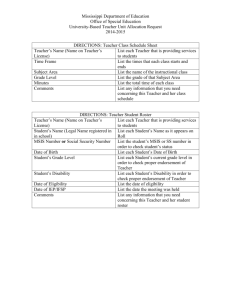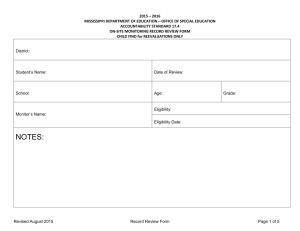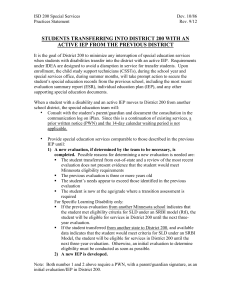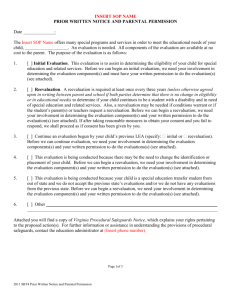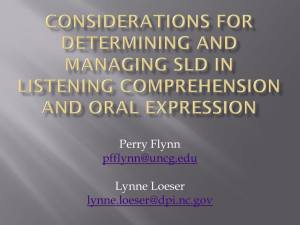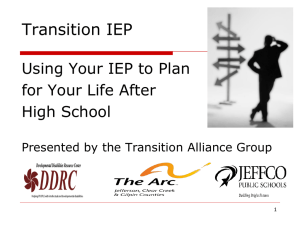Chapter 3: Evaluation
advertisement
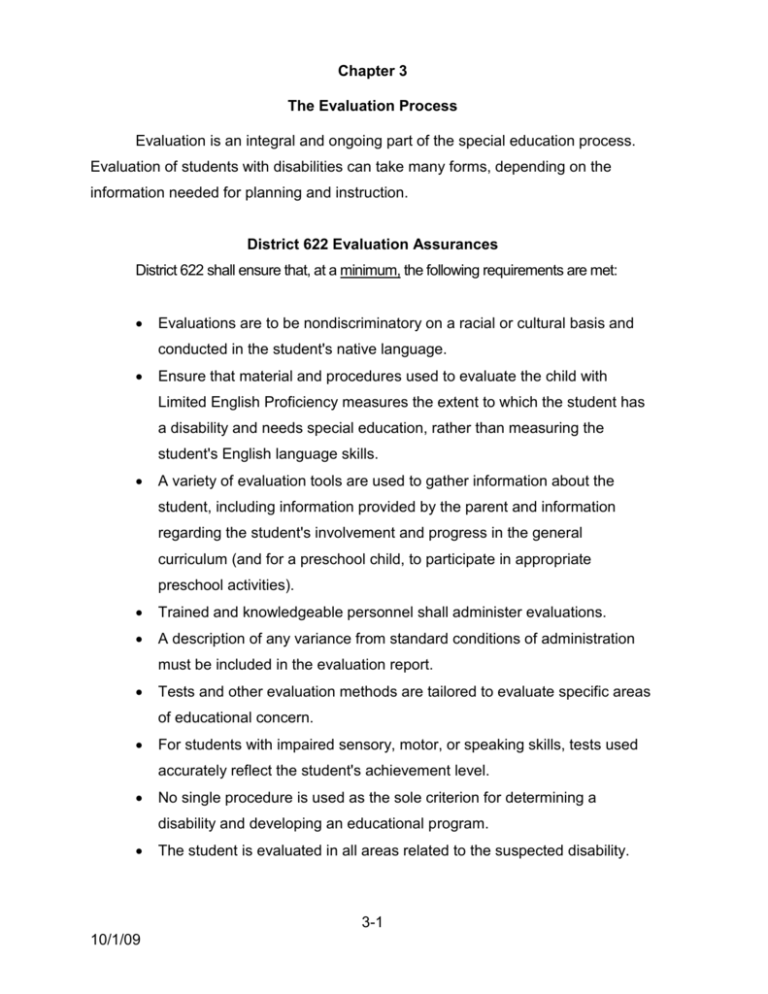
Chapter 3 The Evaluation Process Evaluation is an integral and ongoing part of the special education process. Evaluation of students with disabilities can take many forms, depending on the information needed for planning and instruction. District 622 Evaluation Assurances District 622 shall ensure that, at a minimum, the following requirements are met: Evaluations are to be nondiscriminatory on a racial or cultural basis and conducted in the student's native language. Ensure that material and procedures used to evaluate the child with Limited English Proficiency measures the extent to which the student has a disability and needs special education, rather than measuring the student's English language skills. A variety of evaluation tools are used to gather information about the student, including information provided by the parent and information regarding the student's involvement and progress in the general curriculum (and for a preschool child, to participate in appropriate preschool activities). Trained and knowledgeable personnel shall administer evaluations. A description of any variance from standard conditions of administration must be included in the evaluation report. Tests and other evaluation methods are tailored to evaluate specific areas of educational concern. For students with impaired sensory, motor, or speaking skills, tests used accurately reflect the student's achievement level. No single procedure is used as the sole criterion for determining a disability and developing an educational program. The student is evaluated in all areas related to the suspected disability. 3-1 10/1/09 Use of technically sound instruments that evaluate the relative contributions of cognitive and behavioral factors in addition to physical and developmental conditions. Use of tools that provide relevant information that directly determine the educational needs of the student. Evaluation procedures reflect the needs of the student being evaluated. Secondary Transition assessments must be addressed in all evaluations at during the students 9th grade year. Multidisciplinary Evaluation Team Prior to beginning the process for an evaluation/reevaluation, a team including the parent, special education teacher, general education teacher, district representative, the student (when appropriate), and other qualified professionals reviews existing data. For initial evaluations, at least one member of the assessment team knowledgeable of the procedures and results should be present. The evaluation team will consult with a staff member licensed in the pupil’s disability to work with the evaluation team whenever an evaluation is developed and/or reviewed. This individual’s name must appear on the notice of team meeting and on the evaluation report, but he/she does not necessarily need to attend the meeting. The IEP team shall include a person knowledgeable concerning racial, cultural, or disabling differences of the pupil, if appropriate. When the student has a non-resident agreement in 622, the team must invite a member from the resident district to attend the meeting. A copy of all paperwork (ex. IEPs, ASRs, etc.) must be sent to the resident district. This team then determines what additional data is needed to determine whether a student has a disability and is in need of special education service. The evaluation must be conducted by a multidisciplinary team. Evaluation teams should refer to the criteria checklists to determine what additional data is needed based on the type of evaluation that is conducted. A parent should be offered to have a face to face multidisciplinary evaluation meeting. However, this task may be completed by phone or by email. The 3-2 10/1/09 evaluation plan and a copy of the procedural safeguards is sent home for the parent’s signature. When is Evaluation Needed An evaluation is conducted prior to the beginning of special education services, prior to the determination being made that a student is no longer a student with a disability or had no need for special education services, and/or every three years after a student initially qualifies for services. Evaluation is also required for a change in the primary disability of a student. IEP teams must initiate and complete an evaluation prior to dismissing students from all special education services. Once evaluation data has been reviewed and documented in an evaluation report that the student no longer demonstrates a need for services, IEP teams can dismiss the student from service using the Prior Written Notice. When students no longer demonstrate a need for a related service, the IEP team can evaluate the child or provide performance data on the goals and objectives. At an IEP team meeting, a related service can be discontinued by documenting the progress through progress reports and data provided in the present level of performance statements. Regular IEP due process procedures must be followed. Initial Evaluation An initial evaluation is for a student who has never been evaluated or for a student who was previously evaluated and determined not eligible for special education, but is being considered for evaluation at a later date. Reevaluation A reevaluation is needed for a student under the following circumstances; A student who is currently receiving special education service and three years have expired since his/her last comprehensive evaluation or whose parent requests a reevaluation, or a student who has turned seven years of age and who has received special education service s through the Developmental Delay (ECSE) 3-3 10/1/09 category . Note: Although this is considered a reevaluation for Due Process paperwork, the student must meet initial criteria for a disability category, or a student who is receiving special education services but is being evaluated under a new set of criteria. A reevaluation is not needed when the child is graduating with a regular high school diploma or is aging-out of public education. However, the district shall provide the parent/student with an Exit Summary Report of the child’s academic achievement and functional performance, which shall include recommendations on how to assist the child in meeting the child’s postsecondary goals. Supplementary Evaluation Reports In some cases, a supplementary (stand alone) evaluation may be needed to document needs not previously identified in the most recent comprehensive evaluation. Examples of supplementary evaluations are functional behavioral assessments, DAPE evaluations, OT evaluations, secondary transition evaluations, and speech/language evaluations. All supplementary evaluations must follow due process evaluation reporting requirements and timelines. When calculating the three year re-evaluation timeline, the stand alone evaluation report date should not be used. Refer to the date of the last comprehensive eligibility evaluation report. Assessment Inventory At the back of this chapter, an assessment inventory provides guidance on uses and limitations of formal assessments used for identification purposes. Ordering of additional protocols is also outlined there. Nondiscrimination Considerations Evaluation teams must consider a child’s racial or cultural status when planning a special education evaluation. Evaluation teams should refer to the District’s Assessment Inventory and discuss the limitations of selected tests so as not to be discriminatory on a racial or cultural basis and are provided and administered in the child’s native language or other mode of communication. As a component of documentation of eligibility, a statement must be made of the team’s 3-4 10/1/09 judgment of the effects of cultural factors, environmental or economic disadvantage or limited English proficiency on the child’s achievement level. Use of Existing Data in an Evaluation The review of existing data includes previous evaluations and information provided by the student’s parent(s), current classroom-based assessments, district wide assessments, observations by teachers and related service providers, and the student’s school records. When using existing data, be sure to include current information. Use of existing data still requires evaluation teams to follow all aspects of the evaluation process, e.g., Notice of Evaluation, Evaluation Report, etc. Notice of Evaluation Form The purpose of this notice is to inform parents of a proposed evaluation/reevaluation plan. A parent’s written consent must be obtained before a district proceeds with an initial evaluation. For a reevaluation, a district may proceed if it can demonstrate and document that it has taken reasonable measures to obtain parent consent and the parent has not responded after 14 calendar days. Reasonable measures to obtain parent consent means more than one attempt. Initial Evaluation Timelines For student’s ages 3-21, the initial evaluation report must be written within 30 school days after receiving parent/guardian signature. The date of the evaluation report signifies completion of the evaluation. For children birth to age 3, the initial evaluation report must be written within 45 calendar days from the date of referral. The date of the evaluation report signifies completion of the evaluation. Reevaluation Timelines For student’s ages 3-21, the reevaluation report must be written within 30 school days after receiving parent signature or after the 14 calendar day lapse if parent did not sign permission. The date of the evaluation report signifies completion of the evaluation. 3-5 10/1/09 For children birth to age 3, the reevaluation report must be written within 45 calendar days from the date of referral or upon receipt of parent signature or after the 14 calendar day lapse if parent did not sign permission The date of the evaluation report signifies completion of the evaluation. Determination and Documentation of Eligibility Upon completing the administration of tests or other evaluation activities, a group of qualified professionals and the parent/guardian of the child must determine whether the child has a disability. Evaluation teams will refer to criteria checklists when planning evaluations, verifying eligibility, and to guide eligibility decisions. The initial evaluation report must document that the student meets the criteria components for a categorical disability. A reevaluation report must document that all criteria components have been addressed, the student continues to have a disability, and the student demonstrates a continuing need for special education services. Criteria checklists do not replace the eligibility statements that are required in the evaluation report. All SLD eligibility/ineligibility decisions should be documented by addressing SLD reporting components in the evaluation report whenever the team is evaluating for a specific learning disability. If teams are considering more than one area of categorical disability, they must document all the criteria components for one categorical disability and provide a consideration statement for other categorical disabilities considered. Dissenting Eligibility Decisions Among Team Members and Minority Reports Minority reports are written when a team member does not agree with a decision regarding eligibility. A special education coordinator should be consulted prior to meeting with parents when a minority report is being considered. Every member of the evaluation team (including the parent) has a right to submit a dissenting opinion. A dissenting opinion could represent more than one evaluation team member. Once a minority report is written, it should be attached to the evaluation report and becomes part of the evaluation report. 3-6 10/1/09 Evaluation Practices A member of the evaluation team who is not the student's teacher must conduct the observation. Observations are required as part of the criteria for most disability areas. Understandable current levels of educational functioning are included. Evaluation team members do not interpret evaluation results as absolute, permanent, or generalized to all other circumstances; IQ tests are used as predictors of future achievement rather than indicators of innate ability. Evaluation results are reported as required to be in compliance with federal and state regulations. It is the responsibility of the team to be familiar with changes in Minnesota and Federal rules. It is the assessor and the team's responsibility to determine if derived scores from an evaluation instrument are a valid representation of a student's skills and abilities. If test results seem to conflict with information gathered from the classroom, family or other historical or anecdotal information, further evaluation and documentation might be appropriate. An assessor should describe the student's approach to task, test-taking behaviors and willingness to attempt and complete a task, organizational skills, etc. in order to verify a student's functioning. Evaluation Report The purpose of an evaluation report is to document a student’s educational needs and determination of eligibility. The evaluation report is the summary of the evaluation/ reevaluation process. Use language and terminology that is understandable to a lay-person; avoid the use of technical jargon and acronyms. The evaluation report must contain the following information: 1. Date of the report 3-7 10/1/09 2. Background information and information reported by parents 3. Evaluation results include a summary of all test results and procedures referred to in the evaluation plan. Documentation must also include considerations affecting it including non-discriminatory features. Scores from standardized instruments are reported as standard scored or in terms of percentiles and explained. Summarize the test information in narrative form. The only scores reported should be relevant to the eligibility decision and should be explained clearly. Do not use "grade equivalent" scores; use standard scores and/or percentile. Address specific strengths and areas of need in each of the areas evaluated. Incorporate test results into the Evaluation Report. The WJ-III Compuscore print out should be used only to assist in the writing of the narrative report. It should be used as a substitute for the narrative report. 4. Present level of performance statements including documentation of student achievement 5. Interpretation of evaluation results & team’s judgment regarding determination of eligibility Educational need statements that are derived from the disability 6. Team members’ names, titles, and signatures (best practice); required for SLD and overrides Specific Learning Disabilities Evaluation Report Components The evaluation team must document the following SLD components in the evaluation report: the existence of severe underachievement in response to general education classroom instruction the existence of severe discrepancy between intellectual ability and achievement the existence of an information processing disorder in a variety of settings observations of relevant behavior of the learner, made by one team member other than the classroom teacher the relationship of that behavior to the learner’s academic functioning 3-8 10/1/09 the existence of any educationally relevant medical finding the discrepancy cannot be corrected without the provision of special education and related services the disability is not the result of visual, hearing, motor impairment, mental retardation, or emotional disturbance, environmental cultural, economic influences, or history of inconsistent educational programming Response to Intervention and Qualifying for SLD At this time there are no guidelines regarding how to determine if a child qualifies for Specific Learning Disabilities due to a lack of Response to Intervention (RTI). Therefore, District 622 staff will continue to use the regression/recoupment model for qualifying for SLD. Secondary Transition Evaluation A secondary transition evaluation is required during a student’s 9th grade year. The secondary transition evaluation may be part of a comprehensive initial or re-evaluation, or occur as a supplementary evaluation. A secondary transition evaluation is a formal process that requires parent permission before it begins. An evaluation planning meeting is required to consider which evaluation tools will be used. Informal assessment tools often provide the team with more information than formal assessment tools. The areas of evaluation and planning must be relevant to the pupil's needs and may include work, recreation and leisure, home living, community participation, and postsecondary training and learning opportunities. There are no criteria to qualify for secondary transition services. Services are based on needs identified by the evaluation team. Functional Behavioral Assessments Functional behavioral assessment (FBA) is a process for gathering information to maximize the efficiency of behavioral supports. An FBA includes a description of problem behaviors and the identification of events, times, and situations that predict the occurrence and nonoccurrence of the behavior. An FBA 3-9 10/1/09 also identifies the antecedents, consequences, and reinforcers that maintain the behavior, the possible functions of the behavior, and possible positive alternative behaviors. An FBA includes a variety of data collection methods and sources that facilitate the development of hypotheses and summary statements regarding behavioral patterns. FBAs must be completed 1) as part of each EBD evaluation or 2) before or not later than 10 business days after either first removing a child for disciplinary reasons for more than 10 school days in a school year or commencing a removal that constitutes a change of placement (the child carries a weapon to school or to a school function or the child knowingly possesses or uses illegal drugs or sells, or solicits the sale of a controlled substance while at school or a school function) SPED Students Moving into the District From Another State: A team must meet to develop an evaluation plan, evaluate the student and determine whether the student meets initial Minnesota eligibility criteria. This new evaluation is considered an initial evaluation, and teams must apply initial criteria. Special education services must be provided through an interim IEP during the evaluation period. Formal testing may not be required if the evaluation data provided by the previous school district meets professional testing standards. Teams must review and document existing data and address Minnesota initial eligibility criteria in the evaluation report. From Another Minnesota School District: A team must meet to review the evaluation report and eligibility. If the team agrees with the current determination, a team meeting is held to adopt the existing IEP or develop a new one. If the team determines a new evaluation is necessary, an evaluation plan is developed to evaluate the student and determine whether the student meets Minnesota eligibility criteria. This new evaluation is considered a reevaluation. Special education services must be provided through an interim IEP during the evaluation period. 3-10 10/1/09 From Minneapolis SNAP: A team must meet to review the evaluation report and eligibility. If the team agrees with the current determination, a team meeting is held to adopt the existing IEP or develop a new one. If the team determines a new evaluation is necessary, an evaluation plan is developed to evaluate the student and determine whether the student meets Minnesota eligibility criteria. This new evaluation is considered a reevaluation. Special education services must be provided through an interim IEP during the evaluation period. Independent Educational Evaluations Parents of a student with a disability have the right to obtain an independent educational evaluation (IEE) at the district’s expense, when they disagree with an evaluation completed by the school district. The district has a right to 1) Initiate a hearing to show that the evaluation completed by the district is appropriate, or 2) Ensure that an IEE is provided at public expense. If an IEE is at public expense, the criteria under which the evaluation is obtained, including the location of the evaluation and the qualification of the examiner, must be the same as the criteria, which the public agency uses when it initiates an evaluation. If a parent obtains an IEE at private expense, the results of the evaluation must be considered by the school district in any decision made with respect to the provision of a free and appropriate public education to the student. Please contact your building special education coordinator if a parent requests an independent evaluation. The coordinator will review the case, determine if the district will comply with the request, and make recommendations to the parent regarding qualified examiners. Team Overrides If the team qualifies a student through an override of criteria, the team must provide an explanation of why commonly used standards and procedures resulted in invalid findings for this student, what objective data were used to conclude the student has a disability and is in need of specialized instruction (may include tests 3-11 10/1/09 scores, work products, self-reporting, teacher comments, observational data, previous testing, ecological assessments, and other developmental data); and, which data had the greatest relative importance for the eligibility decision. Criteria components must still be addressed in an override decision. A special education coordinator must be consulted prior to consideration of a team override to consider consistent implementation district wide. When completing a team override, each team member must sign the report and then indicate whether the report reflects his/her agreement with the team’s conclusion. If the report does not reflect a team member’s conclusion, that person must write and sign a statement presenting his/her conclusion and attach it to the evaluation report. In situations where non-discriminatory procedures have been used in lieu of traditional testing, the team should not check the override box. Storage of Administered Assessment Protocols Test protocols and other evaluation materials are part of the student’s educational record. After the evaluation process has concluded, all materials are kept in the student’s Learner File in the building where the student receives their special education services. Protocols from psychological testing are stored at the District Special Services Office. Psychologists will place a notice in the Learner File. Procedural Safeguards Once a year, a copy of the procedural safeguards must be offered to the parents via an IEP team notice, a Notice of Evaluation/Reevaluation, or Prior Written Notice. Best Practices When Evaluating Students for Special Education 1. Evaluate only in the areas of concern. Never do a series of evaluations (i.e., behavioral, academic, functional, communication) just to rule out a possible need. 3-12 10/1/09 2. Only staff with appropriate training should administer achievement tests. If you feel you are not adequately qualified to administer and/or interpret an achievement test, consult with your school psychologist or special education coordinator. 3. In a situation where SLD and EBD evaluation are being conducted simultaneously, remember to assess fully in both areas. Teams must address the information processing and severe underachievement SLD components when completing the SLD portion of the evaluation. Do not rely on severe discrepancy alone to determine whether a student with behavioral concerns qualifies for SLD services. 4. Dyslexia is a broad term used to describe a variety of reading problems. Students who have been given a medical diagnosis (For example: non-verbal learning disability, dysgraphia, etc…) are not eligible for SLD services unless they meet all three components of the state SLD criteria. 5. When transitioning students from Early Childhood Special Education (ECSE) and considering SLD eligibility, all three components of the SLD criteria must be evaluated. 6. The Evaluation Report must clearly state the eligibility criteria and address all components of the criteria being considered. 7. For a student qualifying for SLD, the evaluation report should state which of the seven LD areas the child qualified: Basic Reading, Reading Comprehension, Math Calculations, Math Reasoning, Listening Comprehensive, Oral Expression or Written Language. Points to Consider When Parents Refuse Consent for Evaluations When your team suspects that a student may have a disability but the parent will not give permission for an evaluation, a difficult situation is created. If you believe that you cannot provide a FAPE without taking this step, you may need to consider some due process options in obtaining permission to evaluate. However, there are a few things you can do to attempt to reach an agreement. If parents have refused to give their permission for an evaluation, ask to meet with them in a conciliation conference, to discuss their concerns. Give them a chance to verbalize 3-13 10/1/09 their reasons for not wanting their child evaluated. Describe the evaluation process and the potential outcomes. Assure them that they would be involved with all decisions made based on the evaluation data. Evaluation may or may not indicate the presence of a disability and the need for special education services. Parents will always be involved in making decisions regarding their child. If the parents are not responding to your notices requesting permission for an evaluation, continue to try reaching them using different methods of communication. Keep careful records of your attempts. In addition, it is a good idea to write a letter that includes a chronology of events leading up to this point. This would include the reasons you would like to conduct the evaluation and the attempts you have made thus far: Inform the parents that you are very willing to work with them, with the goal being to provide an appropriate education for their student in order to promote success. If parents continue to refuse and you feel you cannot provide a FAPE to the student without the evaluation, or if the parent has returned the "Notice of Evaluation/Reevaluation" with a denial of permission, the team should contact the special education coordinator to offer mediation. Hopefully, the parents will attend this conference which will be facilitated by an independent knowledgeable party. If not, the file will be referred to the Director for possible due process hearing procedures. Managing the Evaluation Due Process Documentation When you receive the signed Notice of an Evaluation/Reevaluation Plan make sure to enter the date you receive it in the box on the 2nd page and also calculate the 30 schools days for the evaluation deadline. It is not the date parents signed. If parents don't agree with the evaluation plan they must check the appropriate box, sign and return the form. Then the team must meet with the parents to discuss the issues, develop a new evaluation plan, and obtain parent permission. After the parents have signed the testing permission, make copies of the plan for each person evaluating the student. You have 30 school days to complete the assessment report from the date the signed permission was returned. Communicate with evaluators how they can enter their information into the evaluation report. Ensure that all information is in the report prior to the meeting and have draft 3-14 10/1/09 copies of the evaluation report prepared for the meeting to review it. Completing the Evaluation Process Parents should be provided a copy of the evaluation report prior to the meeting in order to read it over. Arrange a team meeting to go over the Evaluation Summary Report and send out a Notice of Team Meeting. If an IEP needs to be written it is allowable to combine both meetings if time allows. Make sure you check both boxes on the Notice of Team Meeting. Provide the Evaluation Report to the parent(s) at the IEP team meeting held within the 30 day time period for the purpose of discussing the contents of the report. If a meeting cannot be scheduled within the 30 days, a copy of the report should still be provided to the parents within the 30 days. The report can be discussed with interpretation of test results at a subsequent meeting which should be scheduled at a mutually agreeable time, but as close to the 30-day timeline as possible. If you are holding the IEP meeting separate from the Evaluation Summary Report meeting, schedule an IEP meeting within 14 calendar days of the Evaluation Summary Report meeting. 3-15 10/1/09
